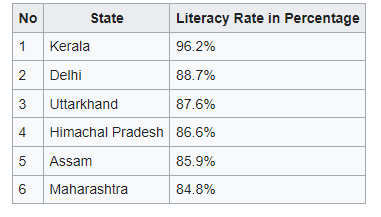Answer:
Literacy in India is a key for socio-economic progress. Despite government programmes, India’s literacy rate increased only “sluggishly”. The 2011 census, indicated a 2001–2011 decadal literacy growth of 9.2%, which is slower than the growth seen during the previous decade. An old analytical 1990 study estimated that it would take until 2060 for India to achieve universal literacy at then-current rate of progress.
Census of India pegged average literacy rate to be 73% in 2011 while National Statistical Commission surveyed literacy to be 77.7% in 2017–18. Literacy rate in urban areas was higher 87.7% than rural areas with 73.5%. There is a wide gender disparity in the literacy rate in India and effective literacy rates (age 7 and above) was 84.7% for men and 70.3% for women. The low female literacy rate has a dramatically negative impact on family planning and population stabillisation efforts in India. Studies have indicated that female literacy is a strong predictor of the use of contraception among married Indian couples, even when women do not otherwise have economic independence. The census provided a positive indication that growth in female literacy rates (11.8%) was substantially faster than in male literacy rates (6.9%) in the 2001–2011 decadal period, which means the gender gap appears to be narrowing.
The United Nations Educational, Scientific and Cultural Organisation (UNESCO) has drafted a definition of literacy as the “ability to identify, understand, interpret, create, communicate, compute and use printed and written materials associated with varying contexts. Literacy involves a continuum of learning enabling individuals to achieve their goals, to develop their knowledge and potential, and to participate fully in their community and wider society.”
The National Literacy Mission defines literacy as acquiring the skills of reading, writing and arithmetic and the ability to apply them to one’s day-to-day life. The achievement of functional literacy implies (i) self-reliance in 3 R’s, (ii) awareness of the causes of deprivation and the ability to move towards amelioration of their condition by participating in the process of development, (iii) acquiring skills to improve economic status and general well-being, and (iv) imbibing values such as national integration, conservation of the environment, women’s equality, observance of small family norms.
The working definition of literacy in the Indian census since 1991 is as follows:
Literacy rateAlso called the “effective literacy rate”; the total percentage of the population of an area at a particular time aged seven years or above who can read and write with understanding. Here the denominator is the population aged seven years or more.

Crude literacy rate The total percentage of the people of an area at a particular time who can read and write with understanding, taking the total population of the area (including below seven years of age) as the denominator.

Literacy Rate in India

The report on ‘Household Social Consumption: Education in India as part of 75th round of National Sample Survey – from July 2017 to June 2018.
Total Views: 26
